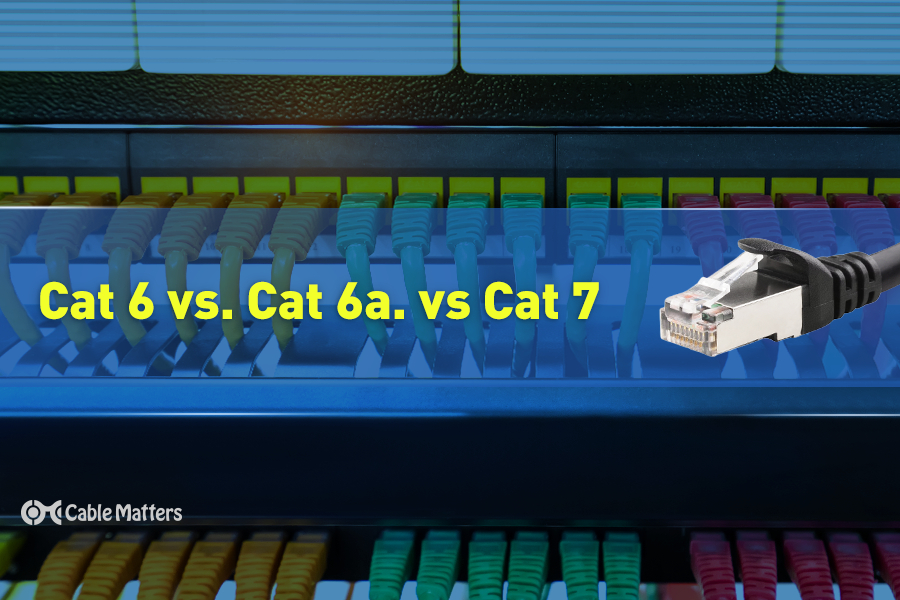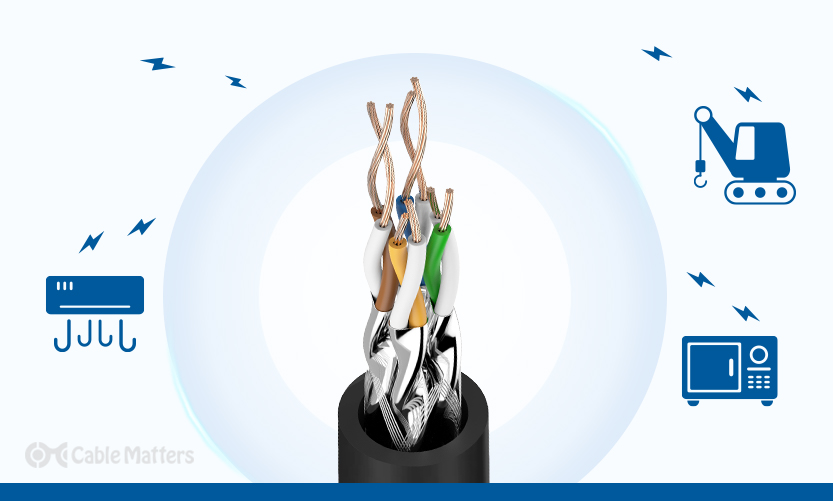
Picking the right Ethernet cable can be a little tricky. With so many generations of cables readily available, and performance and features that are shared by many of them, it’s not obvious why you might want one Ethernet cable over another. However, while you can look at older cables like Cat 5e and the most cutting-edge Cat 8 cables, most potential cable buyers should stick to more mainstream cables. That means you’re looking at Cat 6 vs. Cat 6a vs. Cat 7.
That’s not as straightforward as it might seem, though. Where Cat 6 is a clear evolution of Cat 5e Ethernet cables, and Cat 6a is a further development in turn, Cat 7 is a whole other style of cable entirely. It has less support, non-standard connectors at either end of the cable, and a performance that is as best competitive as Cat 6a.
Still, if you’re looking to buy a new high-performance Ethernet cable, or want to build a high-speed network, you need to know what you’re buying. Understanding Cat 6 vs. Cat 6a vs. Cat 7 is a great place to start, and that’s exactly what this article will help you do.
Cat 6 Ethernet Cables
Cat 6 is a standardized twisted pair Ethernet cable that uses a standard 8P8C connector (colloquially known as RJ45) at each end, and is backward compatible with older Cat 5e, Cat 5, and earlier standards of Ethernet cable. It is characterized by being notably more capable than its predecessors, though, able to operate at up to 10 Gbps at lengths up to 55 meters. Over that length, and up to 100 meters its data rate drops to just 1Gbps, however – in line with Cat 5e performance.
Cat 6 cables are unshielded by design but are built to more robust standards than previous generations of unshielded Ethernet cables. The specification mandates they be made with pure copper wires, rather than copper-clad aluminum. This makes them better protected against crosstalk and noise from the other internal wires within their own twisted pairs. That makes Cat 6 cables better suited than older designs for busier networks and office environments, but still not as strong as fully shielded cables with foil and braided protection against electromagnetic interference.
For home networks, Cat 6 Ethernet cables are some of the best, offering excellent performance over shorter distances, leaving plenty of scope for expanding into 2.5Gbps and 10Gbps network speeds in the future
Cat 6A Ethernet Cables
For more robust, or professional networks where data security is more important, and longer cables may be necessary, Cat 6A cables are well worth considering too. They take everything great about Cat 6 cables and ratchet them up with improved performance, and much better shielding.
Cat 6A cables can support much higher frequencies, making them more capable of handling higher data rates over longer distances. Cat 6A cables are rated for 10 Gbps at up to 100 meters, going beyond the 55-meter maximum of Cat 6 cables.
The design of Cat 6A cables makes them more robust and even without shielding they are more protected against noise and crosstalk. Their wires are wound tighter, keeping their signal more secure against outside interference, but they’re also thicker with more insulation, which offers additional protection against electromagnetic interference.

Alongside shielding options like foil wrapping and metallic braiding, Cat 6A cables can also come fitted with a “spline.” That’s a plastic divider that runs down the length of the cable and helps physically separate the twisted pairs from one another.
The side-effect of that is that like braided shielding, splines introduce additional thickness to a cable, as well as making it more rigid. That does give Cat 6A cables more durability, which can make them last longer before needing a replacement, but it makes installing them more tricky. They’re harder to route through walls and are heavier to carry and transport. That can make them more costly to install, especially if you’re building or upgrading a large network.
Cat 6A cables are the best solution for modern offices and larger home networks where there is a lot of other cabling, or other devices and equipment that could cause interference with older standards of Ethernet cable.
Cat 7 Ethernet Cables
Cat 7 is a unique type of Ethernet cable. It is compatible with other categories of Ethernet cables, but Cat 7 cables are not recognized by the Telecommunications Industry Association (TIA) or Electronic Industries Alliance (EIA) organizations. That lack of endorsement means it’s never really taken off as a standard, despite its impressive specifications.
Cat 7 Ethernet cables can support a higher 600Mhz bandwidth than even Cat 6A and introduced support for 10Gbps Ethernet speed a full four years before Cat 6A was ratified. However, Cat 7 cables do not use standard 8P8C connectors, but rather TERA GG45 connectors. They are compatible with 8P8C, but by virtue of not using that more recognized and supported standard, Cat 7 cables further alienate themselves as atypical, making them less desirable for network installation.
When Cat 6A cables became available a few years after the launch of Cat 7, they cannibalized any potential market for Cat 7. It was further improved to Cat 7A a few years later, and that specific standard did find some use in Europe in niche A/V systems, but ultimately Cat 7 Ethernet cables have been left as a forgotten standard; even if you can still get Cat 7 cables today.
Cat 6 vs. Cat 6a vs. Cat 7: Comparison
Cat 6, Cat 6A, and Cat 7 have a lot of features in common, but there are some real differences between them. That means there are some good reasons to use them, and for Cat 7, some very real reasons that you shouldn’t.
Cat 6, Cat 6A, and Cat 7 can all support up to 10Gbps connections up to 55 meters. But where a Cat 6 Ethernet cable can only transmit up to 1Gbps over cables up to 100 meters in length, Cat 6A and Cat 7 can do 10Gbps over the full 100 meters. Unofficially, Cat 7 can do up to 40 Gbps over 50 meters, but there are newer cables that can do that officially, so it’s not particularly useful.
Cat 6 and Cat 6A cables use standard 8P8C connectors, whereas Cat 7 uses a proprietary GG45 connector. Although the Cat 7 connector is compatible with 8P8C ports, it’s not officially supported by most hardware and may lead to compatibility issues in some network setups.
Cat 6 cables are typically unshielded, but you can buy shielded versions of them. Cat 6A offers a better level of base shielding, with thicker and higher-quality wiring, and thicker insulation, and some come with splines to better protect against crosstalk. However, they are also readily available with a wide range of shielding options, including foil wrapping for the twisted pairs and the overall cable, as well as braiding for the cable itself. There are also versions that use both types of shielding. Cat 7 cables are only available in a shielded form and come with the same range of options.
Cat 6A and Cat 7 cables are thicker and more robust than Cat 6, but that does make them heavier, and harder to install. They aren’t as easy to route through narrow gaps, under carpets, or around corners, and their weight makes transport of large quantities more demanding and more expensive. The cables themselves are also more expensive to buy in the first place.

Which Cable Should You Choose?
When it comes down to Cat 6 vs. Cat 6a vs. Cat 7, the best cable for you depends on what you want to use it for. Cat 6 cables are the cheapest and the easiest to install, but their performance is much less impressive – especially over longer distances. It also offers less protection against electromagnetic interference and crosstalk.
Cat 6A and Cat 7 cables offer comparable performance and levels of shielding. They are also almost identical when it comes to cable thickness, weight, and cost, making them both a little harder to install than Cat 6. Cat 7 cables aren’t standard Ethernet cables, though, with atypical connectors, and a lack of official industry support.
If you’re looking to build a home network or upgrade a small office where external interference is at a minimum, then Cat 6 cables are perfectly fine. They’re affordable, easy to install, and offer excellent performance over shorter distances. For anything else, Cat 6A is the better choice. It has better shielding, uses higher-quality wiring, and its performance is fantastic, even on larger runs.
Cat 7 cables are impressive, and rival Cat 6A in many respects, but their increased cost, use of non-standard connectors, and lack of industry support, means it’s added complexity that you just don’t need to engage with. Cat 6A is as good or better in every way.